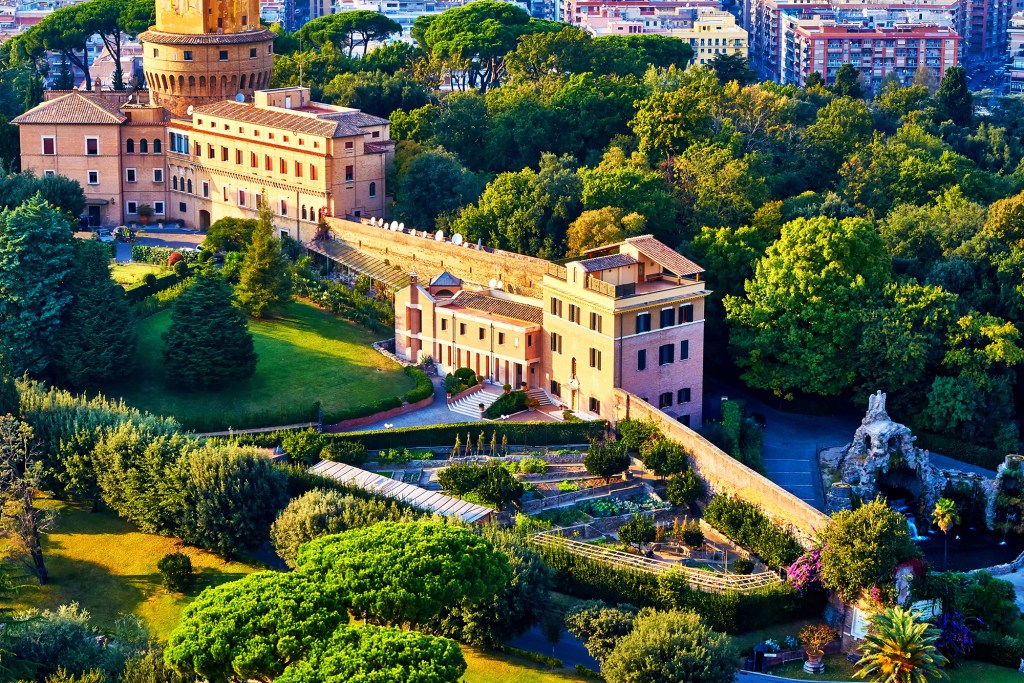While his health has worsened in recent hours, Benedict XVI has not been transferred to one of the many Catholic hospitals in Rome — for example, the Gemelli Polyclinic — but remains at the Mater Ecclesiae Monastery, his residence since 2013. There, he is receiving the necessary medical care.
This little-known Vatican building has now housed the Pontiff Emeritus — almost 10 years at present — longer than the Apostolic Palace, when he was reigning pope.

Where is the Mater Ecclesiae Monastery located?
The Mater Ecclesiae Monastery — Mater Ecclesiae is Latin for “Mother of the Church” — is a building located almost at the top of the Vatican hill, in the heart of the gardens of the small state. Inaccessible unless invited, surrounded by high hedges and guarded by gendarmes, it is located a few meters below the Vatican Radio tower and just above the Casina Pio IV, seat of the Pontifical Academies of Sciences and Social Sciences.
To the south of this nearly 300-square-meter residence, gardeners work in the Vatican’s vegetable garden, while to the north is the 17th-century rocky fountain of the Eagle. The monastery is only 350 meters from the Casa Santa Marta, where Pope Francis lives.

What is the origin of the monastery?
The Mater Ecclesiae Monastery was built between 1992 and 1994 at the request of John Paul II, using a former office of the Vatican Gendarmerie, in order to accommodate small communities of cloistered nuns. The Polish Pope wanted these communities within the Vatican to be able to pray from the heart of the Church for the Successor of Peter and his mission. From 1994 to 1999, it was occupied by Poor Clares; from 1999 to 2004 by Discalced Carmelites; from 2004 to 2009 by 10 Benedictine nuns; from 2009 to the end of 2012 by Visitation nuns.
Why was this chosen to be the Pope Emeritus’ home?
At the end of 2012, the Visitation nuns were invited in great secrecy to return to their monastery, in order to allow the start of refurbishment work, reports Italian journalist Massimo Franco in his book, Il Monastero (Solferino, 2022). It was not until some months later that we learned that Benedict XVI, after his resignation in February 2013, had planned to move there.
Work at Mater Ecclesiae continued until May 2, 2013, the day the now Pontiff Emeritus returned from his stay at Castel Gandolfo to stay there. Since then, the Pontiff has hardly ever left the monastery, except for his regular walks in the gardens, a few rare official appearances and a trip to Germany in 2020 to visit his brother Georg, shortly before Georg’s death.

Who else lives there?
In addition to the Pope Emeritus, the monastery is the home of his secretary and friend, Archbishop Georg Gänswein, who has been assisting the Pontiff since 1996, when he began working for then-Cardinal Ratzinger in the Congregation for the Doctrine of the Faith.
In Mater Ecclesiae, the two men live together with four consecrated laywomen of Memores Domini, the consecrated branch of the Italian movement Communion and Liberation, to which the German Pontiff has always been very close, especially because he was one of the main supporters of the theological journal Communio; he was one of the most eminent collaborators. These four women, who remain anonymous, assist the Pope Emeritus.
His personal secretary, Birgit Wansin, a consecrated laywoman and member of the Schoenstatt movement, returns to Rome every night to sleep at her community residence. Benedict XVI’s brother, Georg Ratzinger, who died in 2020, was also a sometime resident of the monastery.
What is his daily life like?
Little is known about the life of the Pontiff Emeritus since his resignation, other than what is reported by his secretary, Archbishop Gänswein, and a few privileged witnesses who have been invited to the residence. In recent years, the Pope has divided his life between reading and prayer, and celebrating Mass in the small chapel every day with the other residents.
With its extensive library and peaceful surroundings, this place has allowed the theologian to continue working during these years. A music lover, he is also used to listening to music, sometimes played on the residence’s piano.
He also has received many guests, almost six times a week in the early years. After each consistory, the new cardinals have visited him with Pope Francis, as again on August 27.
The last known visitors were the recipients of the prize that bears his name, the Ratzinger Prize, received at the monastery at the very beginning of December.
The Pontiff Emeritus has also long had the habit of leaving his residence in the late afternoon for a walk, during which he would sometimes go to the reproduction of the grotto of Lourdes in the Vatican gardens to pray the Rosary.


